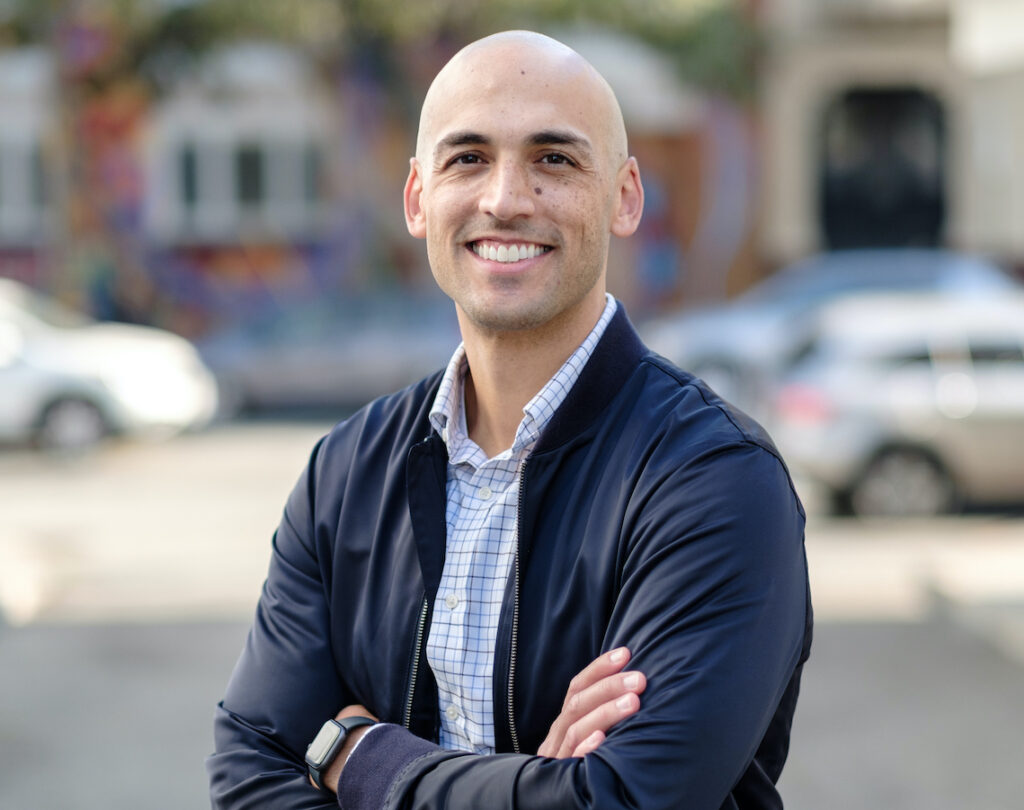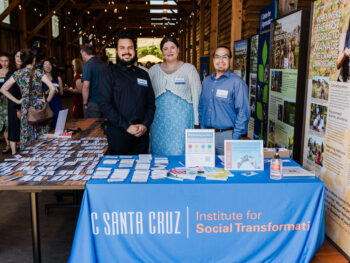Q&A with Forrest Stuart
Associate Professor of Sociology at Stanford University
Interviewed by: Allison Arteaga Soergel, UC Santa Cruz Public Information Representative

Since earning his bachelor’s in politics at the University of California, Santa Cruz back in 2004, Forrest Stuart has gone on to build a highly influential academic career, pursuing burning questions about the societal underpinnings of poverty and criminalization across disciplines. He’s now an associate professor in the Department of Sociology at Stanford University, where he directs the Stanford Ethnography Lab. Stuart has also written two highly influential books: Down, Out and Under Arrest: Policing and Everyday Life in Skid Row and Ballad of the Bullet: Gangs, Drill Music, and the Power of Online Infamy. And, this past fall, a $625,000 funding award from the MacArthur Foundation placed him among a select group of the nation’s top changemakers and creative thinkers. We caught up with Stuart shortly after his MacArthur win to discuss his work and influences, along with his advice for the next generation.
Can you fill us in on what you’ve been up to recently? How would you describe your current role at Stanford?
I have an ethnography lab at Stanford that’s founded on giving students and faculty the resources and community that it takes to do really immersive, humanistic social science. Social forces and social processes, no matter how big they may seem, are always made in these micro moments. And we can’t get to that unless we build intimate relationships with people.
A lot of this work is often done by and alongside communities of color. A lot of my students are first-generation college students, first-generation Ph.D. students, and folks from underrepresented groups. These are people who come into academia with an eye toward their home communities and notice some problems and neglect going on there.
Could you tell us more about the focus areas of your research?
Much of my work is on urban poverty and criminalization. My first book was about what criminalization does to communities, and my most recent book was about gang-affiliated youth and how they’re using social media to gain recognition and deal with their lives.
One of the big takeaways that was really prominent in my first book is that the impacts and scars of police contact linger and influence communities long after the police officer leaves the scene. What might seem to outsiders like a fleeting and inconsequential interaction—like an officer seeing a young man crossing the street and deciding that he wants to stop and frisk him—leaves these deep scars that ripple out into a community well beyond that young man.
Young people start to move through their neighborhoods differently. They may be afraid to leave their homes. How they interact with others on the street changes because they’re always anticipating that an officer might come around. It changes how they choose what to wear. They might ask their little sister to walk with them, which then changes family relationships. Or they ask their girlfriends to walk with them, which then changes the nature of romantic relationships. It changes the ways that mothers interact with their sons because they’re afraid their sons are going to get wrapped up in some of these things.
If we follow the ripples outward, suddenly we look at that singular interaction with an officer very differently. It really makes us question: is it worth it?
What were some of the influences that led you to this type of work?
I trace all of this to growing up in San Bernardino in the 1980s and ‘90s. At the time, it was one of the most impoverished cities in America. It was also, at one point in my childhood, the per-capita homicide capital of America. So, whether it’s at school or with friends or family members, folks are touched by violence and criminalization and mass incarceration.
Growing up, these things were kind of normalized. And then, arriving at UC Santa Cruz, some of the classes I took hit me like a ton of bricks. It was the first time in my life where I was able to trace events, like my friend’s father being gunned down, to the legacies of policies. It gave me a way to rethink a lot of the stuff that I had taken for granted, and also to get really pissed off about it. I finally had a place to look as a source for why this was happening. We don’t have to just throw our hands up in the air and be sad. This is the result of someone making a decision somewhere, and we can actually change those decisions.
It was political theory courses at UC Santa Cruz—thinking about power and hegemony and domination—that made me rethink everything. And I realized, maybe there’s a place for me in this world as an academic who can create the kinds of research that might change some of those discourses and policy decisions and cultural ideologies that are trickling down into the kinds of events that I was seeing and experiencing as a kid.
And now you’re being recognized as a McArthur fellow for these efforts. What does that mean for your future?
It’s been a really amazing validation of the kind of work that I do and that my students do and of the approach to social science that I’m trying to build at Stanford. The fact that not just social scientists, but folks from writers to artists to astrophysicists are now looking at our work and saying “this is important, this is worthwhile, and this is doing something good in the world” is probably the most amazing part.
This has also come at the perfect time. While I was working on my second book, I was alerted to just how much trauma is in the lives of young people in disadvantaged communities in the U.S. and around the globe, and I’ve been trying to figure out a project that really puts trauma at the center. But if I want to have that conversation, it also means that I’m thinking about using some methods that fall outside the realm of the kinds of things that tend to get funded.
I want to involve a few social workers to do this work alongside me who are trained in trauma-informed services. What would it look like to not just study people as though they are in a Petri dish as research subjects, but to involve them as co-producers of knowledge and do so in a trauma-informed way? I also think there’s a lot of power in documentary media. The introduction of photography changes the power relationships in research. People can represent themselves in new ways that can’t happen when it’s just me telling their story on a page. So I’ve also been working with a photographer to try to do some visual ethnography.
But when you’re doing this type of work and having conversations that aren’t necessarily being had in the sociology literature, it’s hard to get funding for that. It’s outside of the box. It’s methodologically and analytically different. So I’m really excited that, suddenly, as I’m coming up with these ideas and sitting here stressing out about how I’m ever going to get funding for this project that I think is so important, here comes a nice chunk of funds from the MacArthur fellowship to support that.
Can you tell us a bit more about your vision for your next project?
Psychologists and social workers talk about trauma, but political scientists and sociologists don’t talk much about trauma; we kind of cede it. And when sociologists talk about violence, we talk about masculinity, and we talk about material deprivation, and these things are part of it. But while I was in Chicago working on my second book, many of the young people that I met had watched a good friend gunned down in front of them by the time they hit puberty. Brothers and sisters and mothers were burying loved ones who had not yet hit their 18th birthday.
The level of that type of thing is something that I don’t think sociologists have language or frameworks or methodologies for. So my next project will hopefully be a return to Chicago to some of the same neighborhoods that I focused on for my most recent book, and I want to focus more on the folks who are often not talked about when we’re talking about urban violence. I already wrote a book about young men engaged in urban violence. I want to put them outside of the focus now, and I want to focus on mothers and sisters and girlfriends.
One of the things I learned is that there is this infrastructure of support and emotional labor that’s going on in marginalized communities that remains invisible to a lot of researchers and to policymakers and the criminal justice system. I want to focus on them as a way of thinking about who is “allowed” to be traumatized. Who’s given the room in society to mourn? How does inequality play out in terms of who’s allowed to experience emotions and loss? There’s a ton of secondary stigmatization that comes into play there.
It sounds like there’s a lot of important work on the horizon for you. When you think back on your journey thus far, is there any advice you’d like to share with young scholars who are just starting out?
I still remember taking this contemporary political theory course at UC Santa Cruz, which was a world-shaping class for me, but I was also kind of struggling in the class. It was some pretty dense stuff. So I went to the lecturer, and I asked him if he had any suggestions. What he said still sticks with me today. I remember he told me to figure out what your big question is in your life, then think about everything you read and every class you take as getting you closer to finding an answer to that question. It gave me this entirely new framework. Find that question, then figure out what it takes to answer that question, and follow that path.
To me, coming from San Bernardino, there were two questions. The first was, why does my hometown look the way it does: why is my city so decaying and distressed? And the second question was, how do we change that? If I just held that in the front of my mind, it made every class personal and relevant. It made every class feel like it was walking me closer to the answers that I was looking for.
I think I’m much closer now to finding those answers. I think I’ve gotten some pretty darn good answers to that first question. The second half of my professional career will hopefully be dedicated to that second part of the question, which is, how do we change places like San Bernardino for the better?










 Delivering Insecurity: E-commerce and the Future of Work in Food Retail
Delivering Insecurity: E-commerce and the Future of Work in Food Retail
